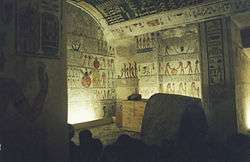KV9
| KV9 | |||
|---|---|---|---|
| Burial site of Ramesses V & Ramesses VI | |||
 | |||
 KV9 | |||
| Coordinates | 25°44′24.6″N 32°36′04.7″E / 25.740167°N 32.601306°ECoordinates: 25°44′24.6″N 32°36′04.7″E / 25.740167°N 32.601306°E | ||
| Location | East Valley of the Kings | ||
| Discovered | Open in antiquity | ||
| Excavated by |
James Burton Georges Daressy | ||
|
| |||
Tomb KV9 in Egypt's Valley of the Kings was originally constructed by Pharaoh Ramesses V. He was interred here, but his uncle Ramesses VI later reused the tomb as his own. The layout is typical of the 20th dynasty – the Ramesside period – and is much simpler than that of Ramesses III's tomb (KV11). The workmen accidentally broke into KV12 as they dug one of the corridors.
The tomb was featured in the first episode of the 2005 BBC documentary series How Art Made the World.
Decoration

The entrance is decorated with a disk containing a scarab and an image of the ram-headed Ra between Isis and Nephthys who are kneeling. The jambs and thicknesses, mentions the name of Ramesses VI. The jambs are usurped from Ramesses V.[1]
First corridor
On both sides are images of Ramesses VI before Ra-Harakhti and Osiris. The scenes originally depicted Ramesses V but were usurped. On the south wall of the corridor are scenes from the Book of Gates, while the North wall is decorated with scenes from the Book of Caverns.[1]
Hall
_fifth_division.jpg)
The corridor ends in a hall that is decorated with an intricate astronomical ceiling.[2] On the left (south) wall the Book of Gates is continued. The decorations show divisions 10 and 11 including Nun holding up the bark of Ra with Nut above the scene. On the right side of the hall (the north) the Book of Caverns scenes continue. Above the entrance to the next corridor the king is shown censing and libating before Osiris. Ramesses Vi is shown is a variety of scenes before gods and goddesses such as Meretseger, Khons, Ptah and Ptah-Sokar-Osiris.[1]
Second corridor
In the descent to the second corridor the decorations show scenes from the Book of the Imi-Duat. The ceiling depicts the barks of Ra and the Books of the Day and Night. Ramesses Vi is shown before Hekau, and Maat.[1]
Hall and burial chamber
The last hall contains scenes from the Book of the Dead and the Book of Aker.[1]
References
- 1 2 3 4 5 Porter, Bertha and Moss, Rosalind, Topographical Bibliography of Ancient Egyptian Hieroglyphic Texts, Statues, Reliefs and Paintings Volume I: The Theban Necropolis, Part 2. Royal Tombs and Smaller Cemeteries, Griffith Institute. 1964, pg 511-517
- ↑ Dodson, Aidan and Ikram, Salima, The Tomb in Ancient Egypt, Thames and Hudson, 2008, pg 227-9
- Reeves, N & Wilkinson, R.H. The Complete Valley of the Kings, 1996, Thames and Hudson, London.
- Siliotti, A. Guide to the Valley of the Kings and to the Theban Necropolises and Temples, 1996, A.A. Gaddis, Cairo.
External links
| Wikimedia Commons has media related to KV9. |
- Theban Mapping Project: KV9 - Includes description, images and plans of the tomb.
- Views of KV9 & KV12